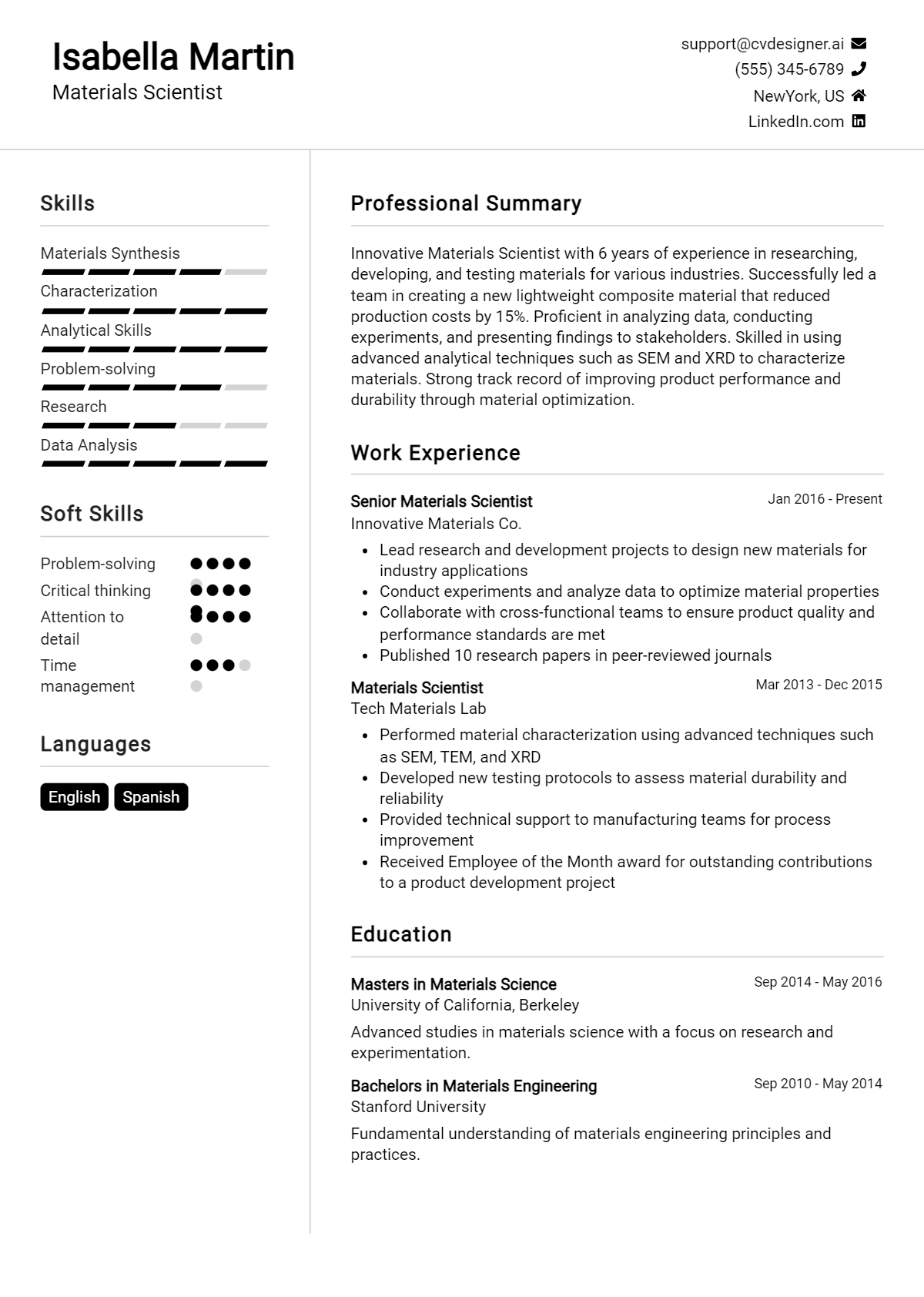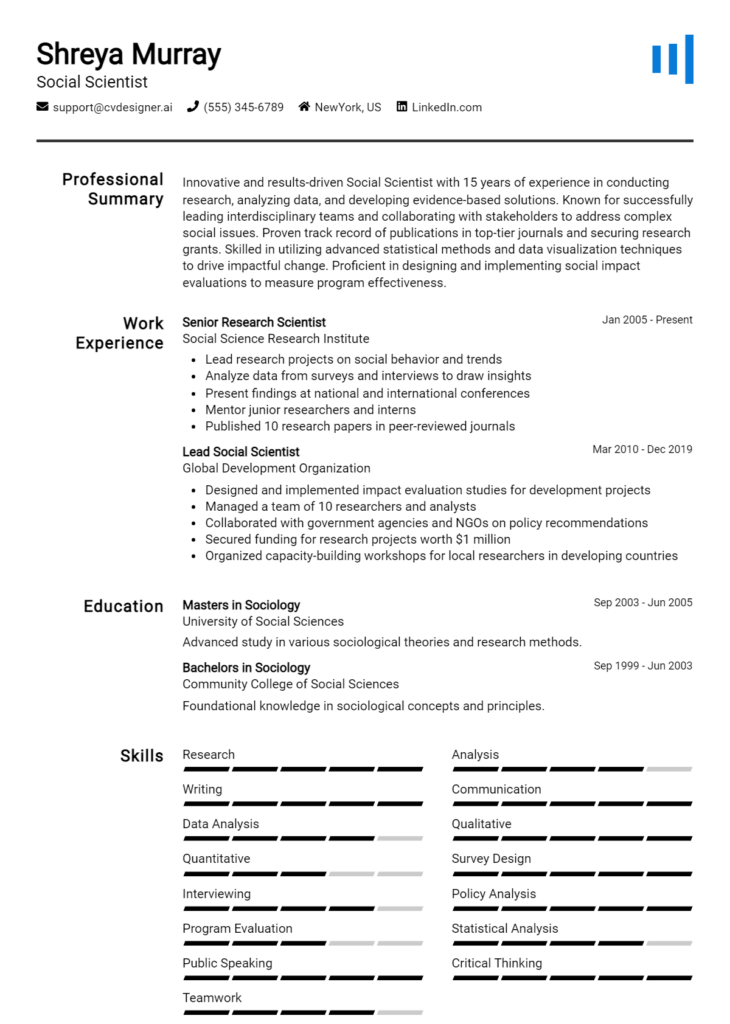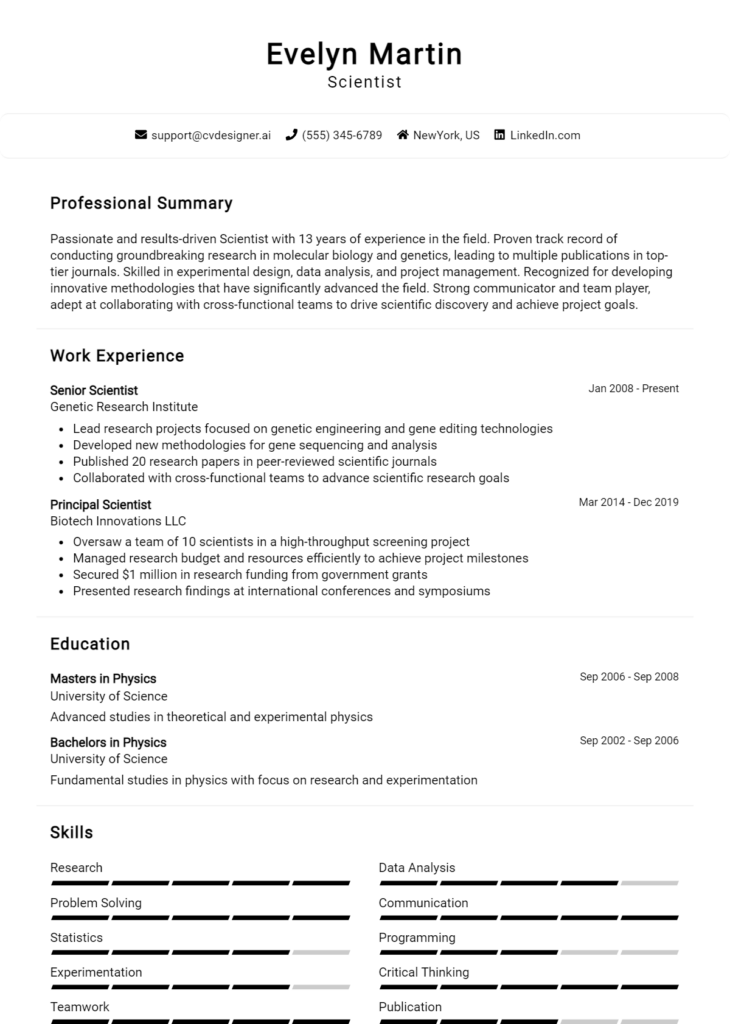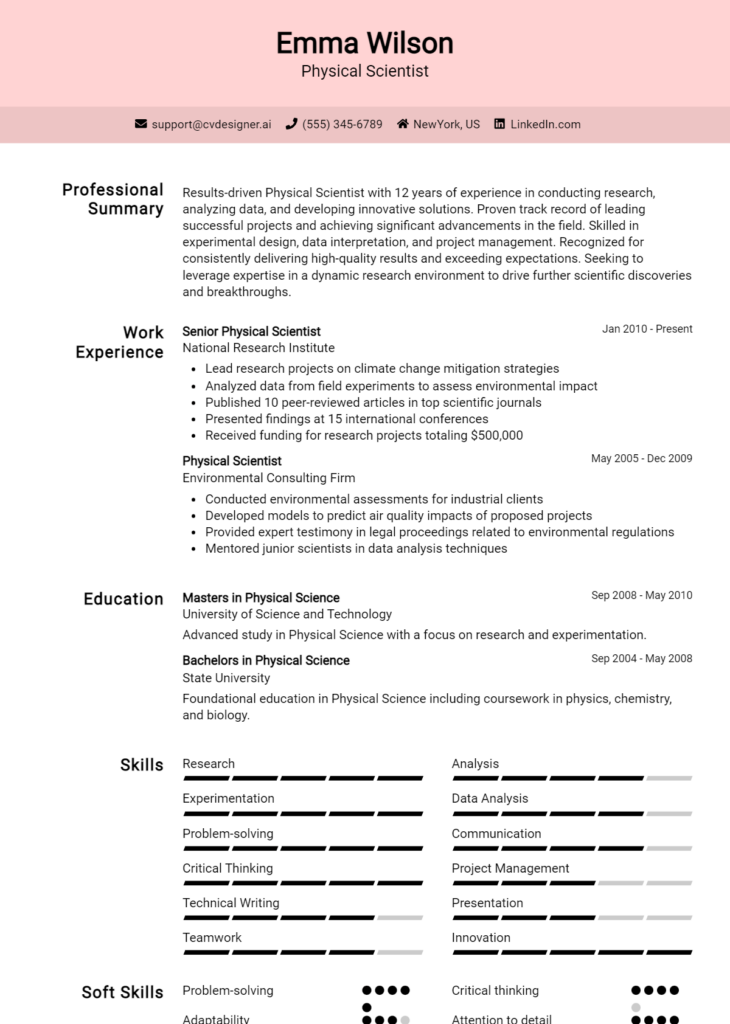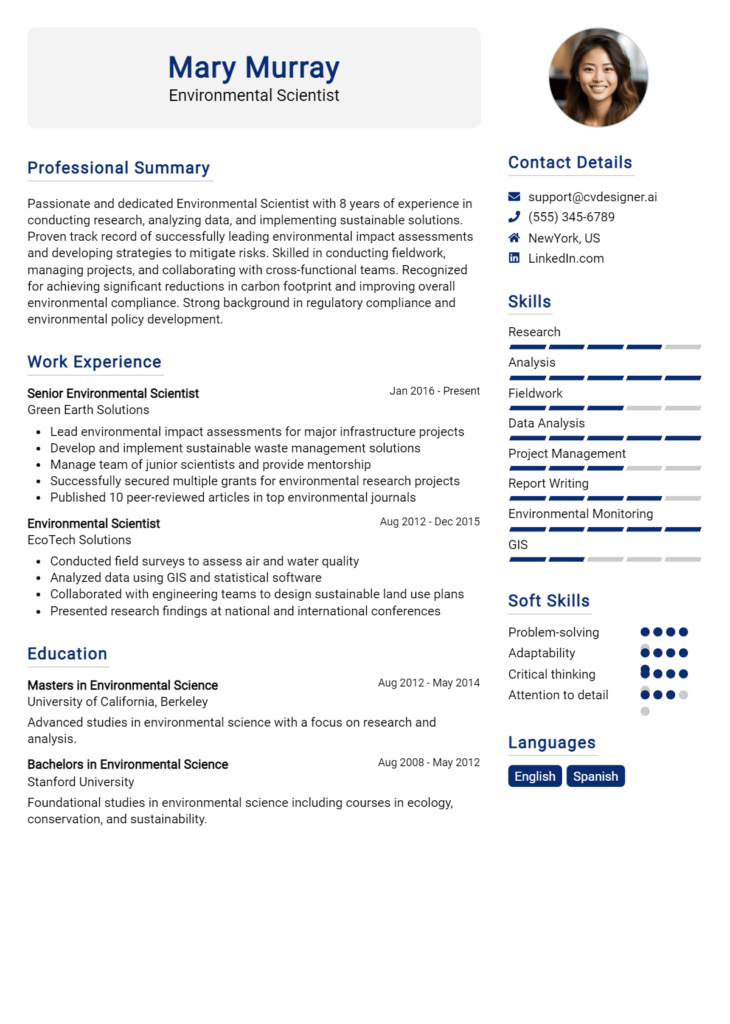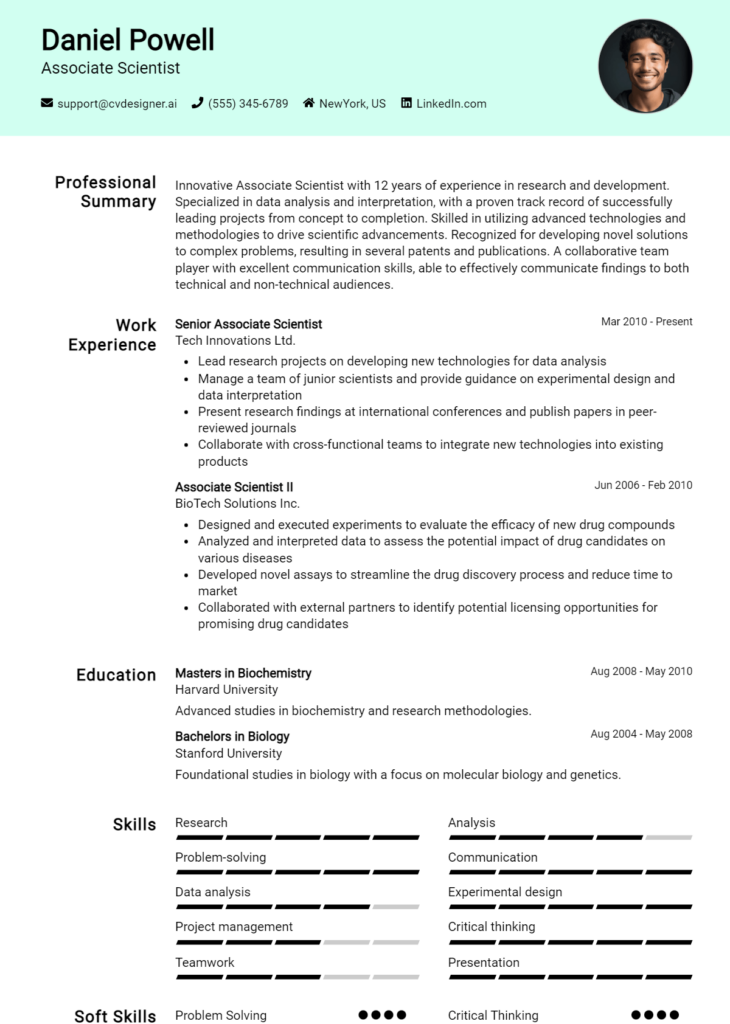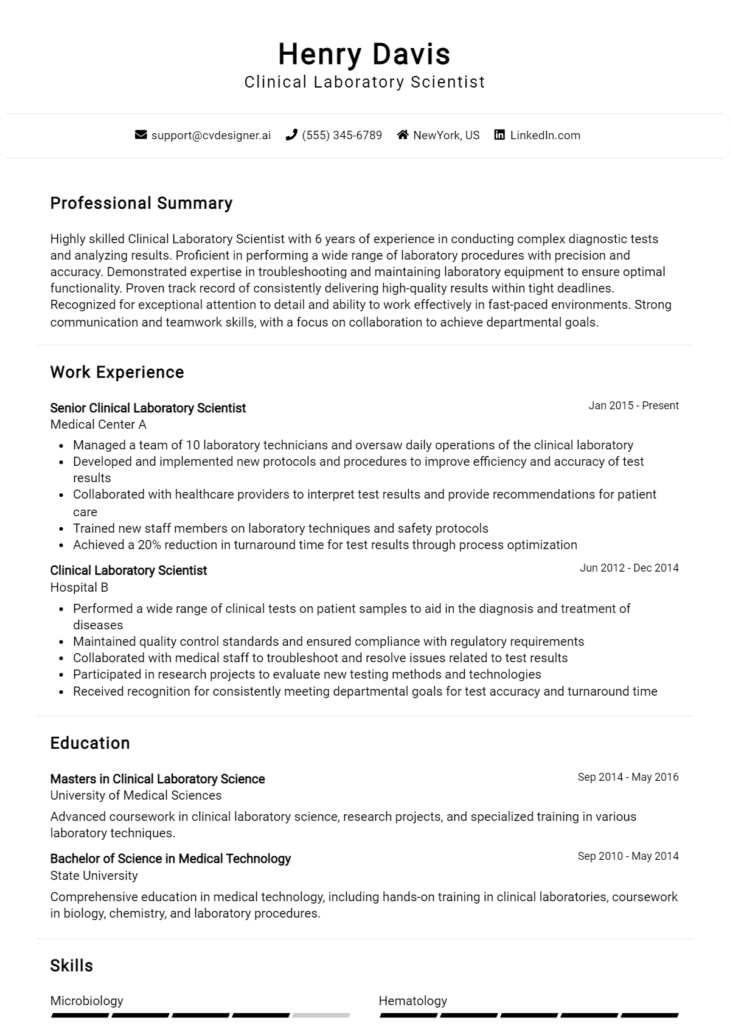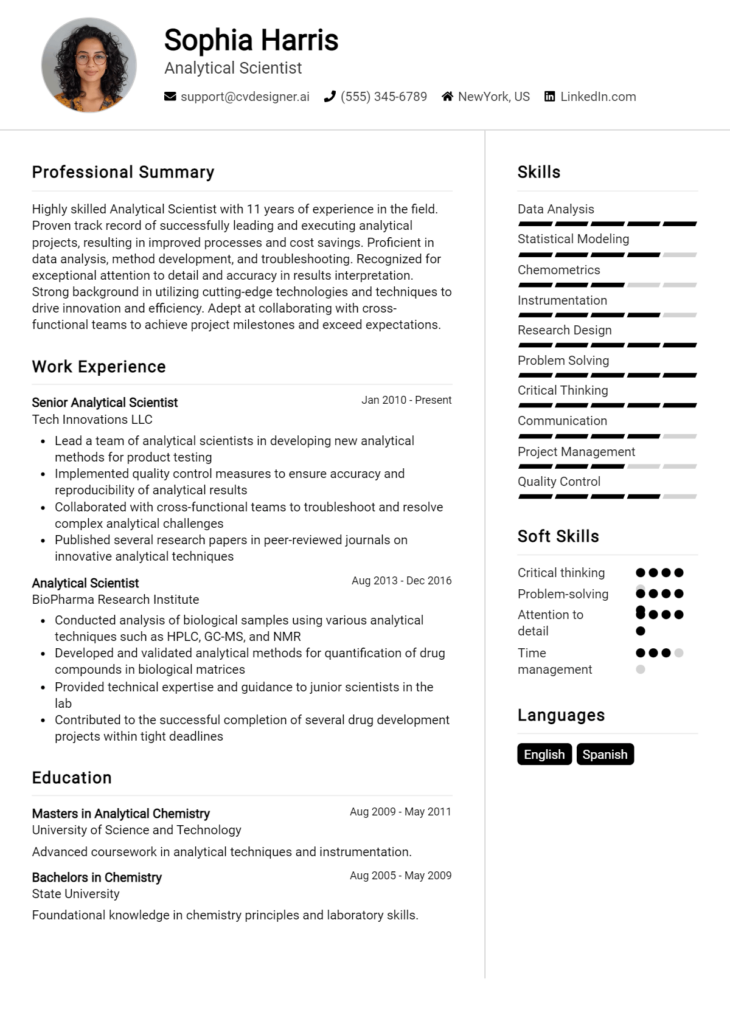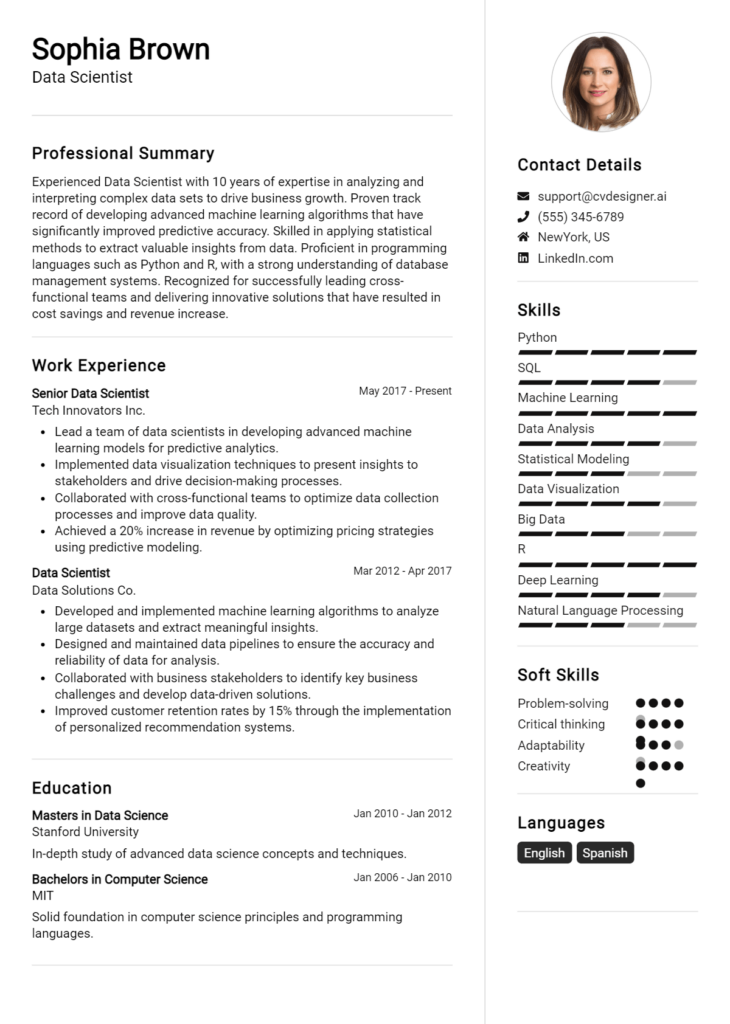Most Popular Materials Scientist Resume Examples
Explore additional Materials Scientist resume samples and guides and see what works for your level of experience or role.
As a Materials Scientist, you stand at the forefront of innovation, playing a crucial role in developing and improving materials that drive advancements across various industries, from aerospace to biomedical applications. Your expertise in understanding the properties, behaviors, and applications of materials can significantly influence product performance and sustainability. However, to land your dream job in this competitive field, a well-crafted resume is essential. It serves as your first impression to potential employers, showcasing your qualifications and unique contributions to the science of materials.
In this comprehensive resume writing guide, we will delve into key aspects that every aspiring Materials Scientist should consider. You'll learn about the core responsibilities and essential skills that define this role, ensuring your resume highlights your relevant experiences effectively. We’ll discuss the best formats to use for maximum impact and outline common mistakes to avoid that could undermine your candidacy. Additionally, we’ll provide resume examples tailored for various career levels—from entry-level positions to seasoned professionals. You’ll also find valuable tips on crafting a standout resume and selecting the right resume templates to make your application visually appealing. Whether you’re starting your career or seeking advancement, this guide will equip you with the tools needed to create a compelling resume that captures the attention of hiring managers.
Key Responsibilities and Skills for a Materials Scientist
As a Materials Scientist, your primary responsibilities involve researching, developing, and testing materials to meet specific performance criteria and applications. You will play a crucial role in various industries, including aerospace, automotive, electronics, and pharmaceuticals. Additionally, you will analyze the properties and structures of different materials, conduct experiments, and collaborate with engineers and other scientists to innovate and improve material design and functionality.
Key Responsibilities:
- Conduct experiments and tests on materials to evaluate their properties and performance.
- Develop new materials and improve existing ones for various applications.
- Analyze data and interpret results to make informed decisions about material usage.
- Collaborate with cross-functional teams to address material-related challenges in product development.
- Document findings and present results to stakeholders through reports and presentations.
- Stay updated on industry trends, technologies, and regulations related to materials science.
Essential Skills:
- Strong analytical and problem-solving skills.
- Proficiency in materials characterization techniques (e.g., SEM, XRD, FTIR).
- Knowledge of material properties and their applications.
- Experience with computational modeling and simulation tools.
- Excellent communication and teamwork abilities.
- Attention to detail and strong organizational skills.
Highlighting these skills effectively in your resume skills section is vital for attracting the attention of potential employers. Tailoring your listed responsibilities and skills to align closely with the job description can significantly enhance your candidacy. Additionally, consider how these skills can be showcased in creating a strong CV, demonstrating not only your technical expertise but also your ability to contribute to the goals of the organization.
Best Resume Format and Structure for a Materials Scientist
When crafting a resume for a Materials Scientist position, it’s important to follow a clear and professional format that highlights your qualifications effectively. Here’s a detailed guide on the best resume structure, including key sections and tips for each.
Contact Information
- Your full name
- Phone number
- Professional email address
- LinkedIn profile or personal website (if applicable)
- Location (city and state)
Professional Summary
This is a brief section (2-4 sentences) summarizing your experience, skills, and what you bring to the table as a Materials Scientist. Tailor this summary to the specific job you are applying for, emphasizing relevant expertise and accomplishments. Include keywords from the job description to improve compatibility with applicant tracking systems (ATS).
Work Experience
List your work experience in reverse chronological order, starting with your most recent position. For each role, include:
- Job title
- Company name
- Location (city and state)
- Dates of employment (month/year)
- Bullet points detailing your responsibilities and achievements. Focus on quantifiable results and specific materials science projects, techniques, or technologies you have worked with. Use action verbs to convey impact and initiative.
Education
Include your most relevant educational qualifications, listed in reverse chronological order. For each degree, provide:
- Degree obtained (e.g., Ph.D., M.S., B.S.)
- Major (e.g., Materials Science, Engineering)
- University name
- Location (city and state)
- Graduation date (month/year)
- Any relevant coursework or research projects can be included, especially if they align with the job description.
Skills
Highlight both technical and soft skills relevant to the Materials Scientist role. Consider including:
- Technical skills (e.g., materials characterization techniques, knowledge of specific materials, modeling software)
- Laboratory skills (e.g., SEM, XRD, FTIR, mechanical testing)
- Soft skills (e.g., problem-solving, teamwork, communication)
- Be specific and consider using keywords from the job listing.
Certifications
Include any relevant certifications that enhance your candidacy, especially those related to materials science or engineering. This could include:
- Professional Engineer (PE) license
- Certified Materials Professional (CMP)
- Any other industry-recognized certifications
Additional Sections (if applicable)
- Publications: If you have published research or articles, list them in a separate section.
- Professional Affiliations: Membership in relevant organizations (e.g., ASM International, Materials Research Society) can be included.
- Conferences and Workshops: Participation in relevant industry events can showcase your commitment to professional development.
Tips for the Resume Format
- Consistency: Use uniform fonts, bullet styles, and spacing throughout your resume.
- Readability: Choose a clean, professional font (e.g., Arial, Calibri) and keep font size between 10-12 points.
- Length: Aim for a one-page resume if you have less than 10 years of experience; two pages are acceptable for extensive experience.
- Customization: Tailor your resume for each application by emphasizing the most relevant experiences and skills.
Cover Letter Complement
Your resume format should complement your cover letter format. Use the same font and style to create a cohesive look. In your cover letter, expand on the key achievements listed in your resume and explain how they relate to the position. Highlight your enthusiasm for the role and the company, demonstrating how your background as a Materials Scientist aligns with their goals.
By following this structured approach, you can create a compelling resume that effectively showcases your qualifications and makes a strong impression on potential employers in the field of materials science.
Writing Tips and Best Practices for a Materials Scientist Resume
When crafting a resume as a Materials Scientist, it's essential to present your qualifications and accomplishments in a clear, organized manner that highlights your expertise in materials properties, processing, and applications. Use a professional format that enhances readability and keeps your content concise. Consider tailoring your resume to the specific job description, ensuring that you include relevant experiences and skills. Utilize action verbs to convey your contributions effectively, and quantify your achievements whenever possible to demonstrate your impact in previous roles. Incorporating industry-specific keywords not only helps your resume pass through applicant tracking systems but also shows your familiarity with the field. Remember to utilize resume writing tips to ensure a polished and professional appearance. As you draft your resume, also think about how these practices can enhance your cover letter and reinforce your candidacy.
- Use strong action verbs such as "developed," "analyzed," and "optimized" to describe your work.
- Quantify your accomplishments with specific metrics, such as "reduced material costs by 15% through innovative sourcing."
- Incorporate industry-specific keywords that reflect your expertise, such as "composite materials," "nanotechnology," or "metallurgy."
- Tailor your resume for each application by aligning your skills and experiences with the job description.
- Highlight relevant certifications or training that enhance your qualifications in materials science.
- Organize your resume into clear sections, such as Education, Professional Experience, Skills, and Publications.
- Use bullet points for easy readability, ensuring each point succinctly conveys your contributions.
- Keep your resume to one or two pages, focusing on the most relevant and impactful information.
Common Mistakes to Avoid in a Materials Scientist Resume
When crafting a resume as a Materials Scientist, it's crucial to present your qualifications and experiences effectively to stand out in a competitive job market. However, many candidates make common mistakes that can undermine their chances of landing an interview. By avoiding these pitfalls, you can create a more impactful resume that highlights your expertise and suitability for the role. Here are some common mistakes to steer clear of:
- Overloading the resume with excessive information that can overwhelm the reader.
- Using generic descriptions that fail to convey specific skills or achievements.
- Neglecting to tailor your resume for the specific job or industry, resulting in a lack of relevance.
- Failing to quantify accomplishments with measurable outcomes, making achievements seem less impressive.
- Ignoring formatting and layout, which can lead to a cluttered or unprofessional appearance.
- Using technical jargon or acronyms without explanations, potentially alienating non-specialist reviewers.
- Omitting important sections, such as relevant coursework, certifications, or publications that showcase expertise.
- Including outdated or irrelevant experience that does not align with the desired position.
- Not proofreading for errors in spelling, grammar, or punctuation, which can detract from professionalism.
- Lacking a clear objective or summary statement that outlines your career goals and what you bring to the table.
To ensure your resume shines, consider reviewing these common mistakes to avoid in a resume. Additionally, don't forget to pay attention to your cover letter as well; mistakes in that document can also hinder your chances. Learn more about the common cover letter mistakes to avoid for a comprehensive application strategy.
Sample Materials Scientist Resumes
As a Materials Scientist, your resume is a critical tool in showcasing your expertise in the development, analysis, and application of materials in various industries. Whether you're an experienced professional, a recent graduate, or transitioning from another career, it's essential to highlight your relevant skills and experiences effectively. Below are three sample resumes tailored to different experience levels that can serve as a guide in crafting your own.
Experienced Materials Scientist Resume Sample
John Doe
123 Science Lane
City, State, Zip
(123) 456-7890
johndoe@email.com
Professional Summary
Results-oriented Materials Scientist with over 10 years of experience in materials development, characterization, and process optimization. Proven track record of leading innovative projects that enhance product performance and sustainability. Strong expertise in polymer science, nanomaterials, and structural analysis.
Education
Ph.D. in Materials Science
University of Technology, City, State
Graduated: May 2012
B.S. in Chemical Engineering
University of Science, City, State
Graduated: May 2008
Professional Experience
Senior Materials Scientist
Innovative Materials Corp, City, State
June 2016 – Present
- Led a team of researchers in developing bio-based polymer composites, resulting in a 30% reduction in production costs.
- Conducted detailed mechanical and thermal analysis to improve material properties, achieving high-performance standards.
- Collaborated with cross-functional teams to integrate new materials into product lines, increasing market competitiveness.
Materials Research Scientist
Advanced Materials Lab, City, State
July 2012 – May 2016
- Developed novel nanostructured materials for energy applications, resulting in a patent for a breakthrough energy storage solution.
- Managed laboratory operations and ensured compliance with safety and quality standards.
- Published 10 peer-reviewed articles in high-impact journals.
Skills
- Materials characterization techniques (SEM, TEM, XRD)
- Polymer processing and formulation
- Project management and leadership
- Data analysis and statistical software
Entry-Level Materials Scientist Resume Sample
Jane Smith
456 Research Blvd
City, State, Zip
(987) 654-3210
janesmith@email.com
Professional Summary
Recent graduate with a B.S. in Materials Science and Engineering, eager to leverage academic knowledge and laboratory experience in a challenging Materials Scientist position. Passionate about sustainable materials and innovative research.
Education
B.S. in Materials Science and Engineering
University of Innovation, City, State
Graduated: May 2023
Internship Experience
Materials Science Intern
Green Tech Innovations, City, State
June 2022 – August 2022
- Assisted in the development of eco-friendly packaging materials, conducting tests on biodegradability.
- Collaborated with senior scientists in analyzing material properties using various characterization methods.
- Presented findings to the research team, contributing to ongoing projects.
Research Assistant
University of Innovation, City, State
September 2021 – May 2023
- Conducted experiments focused on the mechanical properties of composites, leading to a presentation at a national conference.
- Maintained laboratory equipment and ensured compliance with safety regulations.
Skills
- Familiar with characterization techniques (FTIR, DSC, TGA)
- Strong analytical and problem-solving skills
- Proficient in Microsoft Office Suite and data analysis software
- Excellent communication and teamwork abilities
Career Changer Materials Scientist Resume Sample
Michael Johnson
789 Career Path Ave
City, State, Zip
(555) 123-4567
michaeljohnson@email.com
Professional Summary
Dynamic professional transitioning from a successful career in mechanical engineering to Materials Science, bringing strong analytical skills and a passion for materials research. Experienced in project management and cross-disciplinary collaboration.
Education
M.S. in Materials Science
University of Change, City, State
Graduated: Expected: May 2024
B.S. in Mechanical Engineering
University of Engineering, City, State
Graduated: May 2015
Relevant Experience
Mechanical Engineer
Tech Solutions Inc., City, State
June 2015 – Present
- Led the design and testing of components for high-performance machinery, focusing on material selection and durability.
- Collaborated with materials scientists to analyze the performance of new materials in mechanical applications.
- Managed multiple projects simultaneously, ensuring timely delivery and adherence to budget constraints.
Volunteer Researcher
Materials Science Research Group, City, State
January 2023 – Present
- Engaged in research projects focused on material degradation and recycling processes, contributing to community outreach initiatives.
- Assisted in laboratory experiments and data collection, developing hands-on experience in materials characterization.
Skills
- Project management and leadership
- Strong foundation in materials properties and applications
- Proficient in CAD software and data analysis
- Excellent communication and interpersonal skills
For more inspiration, feel free to explore additional resume templates. Additionally, don’t forget to check out corresponding cover letter examples to complete your job application package effectively.
Checklist for a Materials Scientist Resume
- Proofread for Spelling and Grammar: Carefully read through your resume to catch any typos, punctuation errors, or grammatical mistakes. Consider using tools or platforms like Grammarly for added assistance.
- Check for Consistency: Ensure that your formatting is uniform throughout the document. This includes font type, size, bullet points, and spacing. Consistency reflects professionalism.
- Tailor Your Resume to the Job: Customize your resume for each application by highlighting the most relevant experiences and skills that align with the specific job description. Use keywords from the job listing.
- Highlight Relevant Skills: Clearly showcase the technical and soft skills that are pertinent to the role of a Materials Scientist. Consider organizing them into categories for better visibility.
- Quantify Achievements: Whenever possible, use specific metrics or results to demonstrate the impact of your work. For example, "Reduced material costs by 20% through innovative sourcing strategies."
- Use Action Verbs: Start bullet points with strong action verbs to convey your responsibilities and achievements effectively. Words like "developed," "analyzed," and "optimized" can enhance your descriptions.
- Include Relevant Certifications: If you have any certifications or specialized training relevant to materials science, ensure they are prominently displayed in your resume.
- Limit Length to One Page: Aim to keep your resume concise, ideally fitting it onto one page. Highlight only the most relevant experiences and skills to avoid overwhelming the reader.
- Seek Feedback: Share your resume with peers or mentors in the field for constructive feedback. They may provide insights that could enhance the clarity or impact of your resume.
- Consider Using an AI Resume Builder: To ensure all elements are well-organized and professionally formatted, consider using an AI resume builder. This tool can help you streamline the creation process.
Following a similar checklist can also be beneficial when creating a CV or cover letter, ensuring all documents are polished and tailored for your job applications.
Key Takeaways for a Materials Scientist Resume Guide
In conclusion, crafting a strong resume is critical for a Materials Scientist aiming to stand out in a competitive job market. By leveraging the examples and tips provided in this guide, you can effectively showcase your skills, experience, and achievements in a way that resonates with potential employers. We encourage you to take the next step towards securing your dream position by downloading a professional resume template from resume templates or exploring our tailored cover letter templates. Additionally, consider utilizing our best resume maker to create a polished and impactful document. Remember, following similar guidelines will also aid in developing a compelling CV and a persuasive cover letter. Your journey to success starts with a well-crafted resume—make sure yours stands out!
